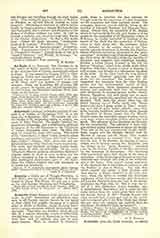

Acoemetae (Greek akoimetai, from privative a and koiman, to rest). Sometimes, an appellation common to all Eastern ascetics known by the rigour of their vigils; but usually, the name of a special order of Greek or Basilian monks devoting themselves to prayer and praise without intermission, day and night. That order was founded, about the year 400, by a certain Alexander, a man of noble birth, who fled from the court of Byzantium to the desert, both from love of solitude and fear of episcopal honors. When he returned to Constantinople, there to establish the laus perennis, he brought with him the experience of a first foundation on the Euphrates and three hundred monks. The enterprise, however, proved difficult, owing to the hostility of Patriarch Nestorius and Emperor Theodosius. Driven from the monastery of St. Mennas which he had reared in the city, and thrown with his monks on the hospitality of St. Hypathius, Abbot of Rufiniana, he finally succeeded in building at the mouth of the Black Sea the monastery of Gomon, where he died, about 440. His successor, Abbot John, founded on the eastern shore of the Bosphorus, opposite Sostenium or Istenia, the Irenaion, always referred to in ancient documents as the “great monastery” or motherhouse of the Acoemetae. Under the third abbot, St. Marcellus, when the hostility of Patriarch and Emperor had somewhat subsided, Studius, a former Consul, founded in the city the famous “Studium” which later, chiefly under Abbot Theodore (759-826), became a center of learning as well as piety, and brought to a culmination the glory of the order. On the other hand, the very glamor of the new “Studites” gradually cast into the shade the old Acoemetae. The feature that distinguished the Acoemetae from the other Basilian monks was the uninterrupted service of God. Their monasteries, which numbered hundreds of inmates and sometimes went into the thousand, were distributed in national groups, Latins, Greeks, Syrians, Egyptians; and each group into as many choirs as the membership permitted and the service required. With them the divine office was the literal carrying out of Psalm cxviii, 164: “Seven times a day have I given praise to Thee,” consisting as it did of seven hours: orthrinon, trite, ekte, enate, luchnikon, prothupnion, mesonuktion, which through St. Benedict of Nursia passed into the Western Church under the equivalent names of prime, tierce, sext, none, vespers, compline, matins (nocturns) and lauds. The influence of the Acoemetae on Christian life was considerable. The splendor of their religious services largely contributed to shape the liturgy. Their idea of the laus perennis and similar institutions, passed into the Western Church with St. Maurice of Agaune and St. Denys. Our modern perpetual adoration is a remnant of it. Even before the time of the Studites, the copying of manuscripts was in honor among the Acoemetae, and the library of the “Great Monastery,” consulted even by the Roman Pontiffs, is the first mentioned by the historians of Byzantium. The Acoemetae took a prominent part—and always in the sense of orthodoxy—in the Christological discussions raised by Nestorius and Eutyches, and later, in the controversies of the Icons. They proved strong supporters of the Apostolic See in the schism of Acacius, as did the Studites in that of Photius. The only flaw which marred the purity of their doctrine and their loyalty to Rome, occurred in the sixth century, when, the better to combat the Eutychian tendencies of the Scythian monks, they themselves fell into the Nestorian error and had to be excommunicated by Pope John II. But it was the error of a few (quibusdam paucis monachis, says a contemporary document), and it could not seriously detract from the praise given their order by the Roman Synod of 484: “Thanks to your true piety towards God, to your zeal ever on the watch, and to a special gift of the Holy Ghost, you discern the just from the impious, the faithful from the miscreants, the Catholics from the heretics.”
J. F. SOLLIER

